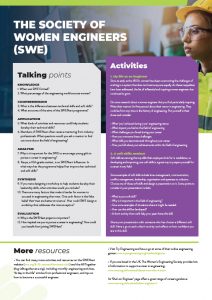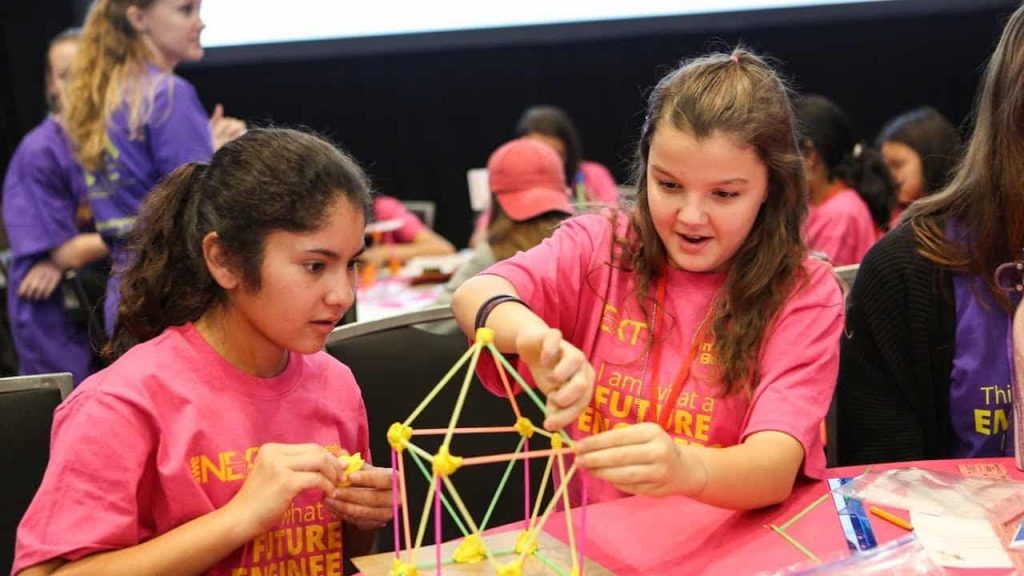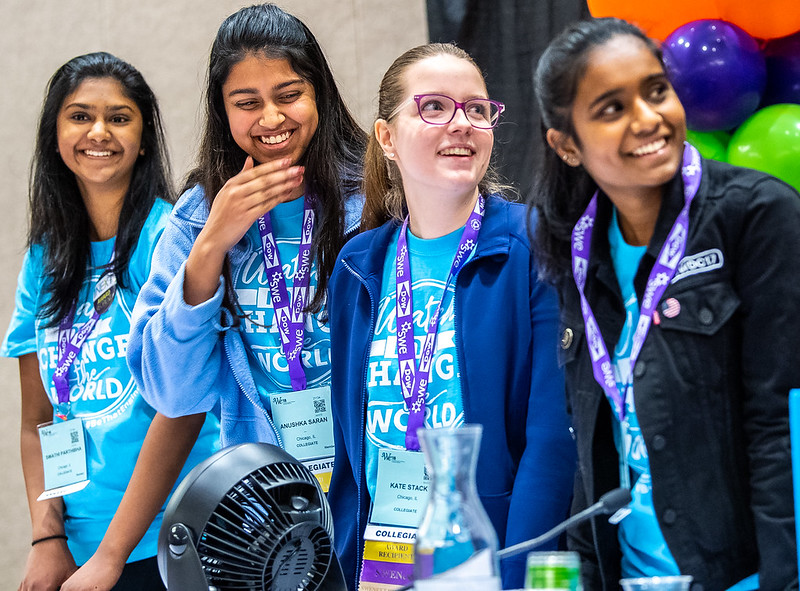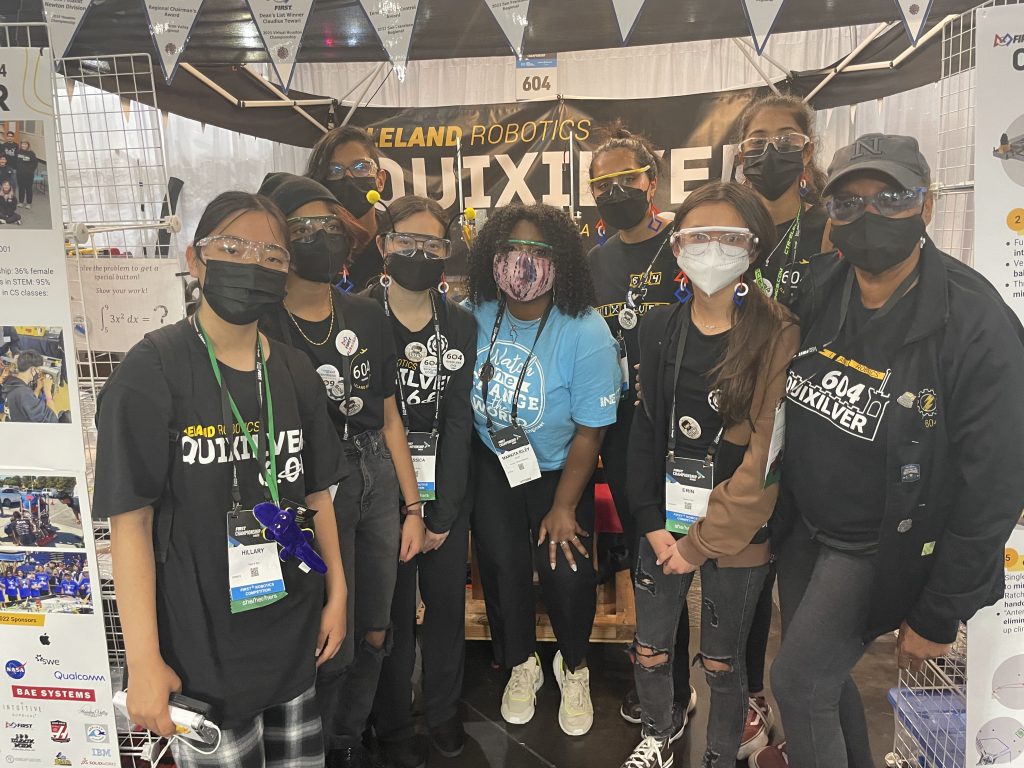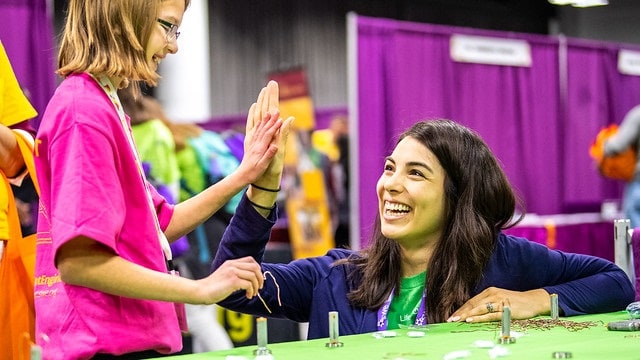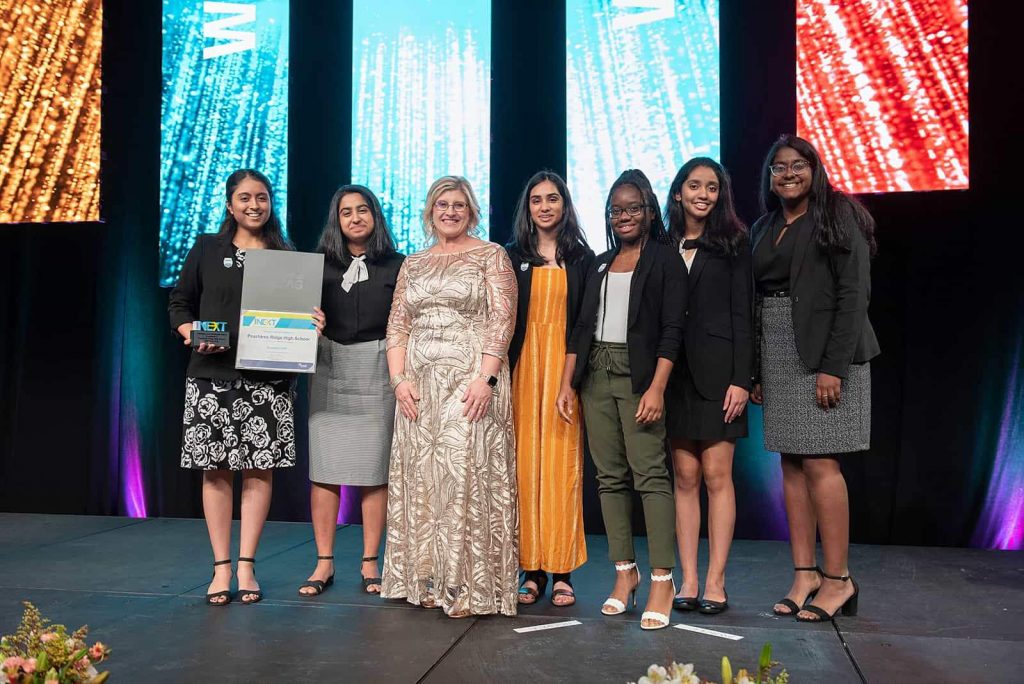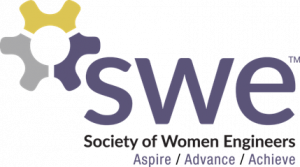Empowering girls, inspiring engineers
Decades of gender stereotyping, discrimination and prejudice have resulted in an engineering work force that is largely made up of white males. Despite changing opinions and increasingly equal access to opportunities, more diversity and inclusion is still needed in the field. The Society of Women Engineers (SWE) in the US is addressing this issue by inspiring young girls to get excited about engineering and to know that they belong.
TALK LIKE AN ENGINEER
BIPOC — Black, Indigenous and People of Colour
TECHNICAL SKILLS — skills that are specific to a particular field. In the field of engineering, these might be the ability the perform equations, build models and design concepts
SOFT SKILLS — personal skills that are relevant in most careers, such as leadership skills, conflict resolution and self-confidence
In 1950, a group of women engineers from the US founded the Society of Women Engineers (SWE). Their goal was to empower women to reach their full potential in the field of engineering and to demonstrate the benefits of inclusion and diversity. Despite significant progress in recent years, women currently account for just over 14% of the engineering workforce.
SWE is working hard on a number of projects to help to turn the tide on engineering’s gender imbalance. One such project is SWENext, a programme designed to enable girls to join the SWE community as students before they turn 18. As SWENexters, students get access to programmes, mentors and resources designed to set them up for a career in engineering. Markita Riley, Outreach and Student Programmes Manager for SWE, is working to inspire young girls to not only consider a career in engineering and technology but to know that their inclusion in the field can make a difference for wider society.
WHAT ARE THE BENEFITS OF BECOMING AN ENGINEER?
Whether it is creating solutions for their local communities or tackling global issues like climate change, engineers have the opportunity to improve the world around them. “Engineering allows you to give back and to pull others up with you,” says Markita. “For example, a few of our corporate partners that are SWE members have been involved in the interior design of The Obama Presidential Centre, a new cultural hub being built in Chicago. The centre will run many programmes aiming to help the communities in its surrounding area.”
Engineers are often at the heart of the projects that they are involved in. From developing a concept to building the finished product, engineers get to contribute to the entire process. The feeling of accomplishment that accompanies the completion of a project is one of engineering’s major benefits. The engineers involved in The Obama Presidential Centre, for example, will be able to look at the finished building in a few years’ time and say, “I had a part in that”.
WHAT OPPORTUNITIES WILL THE FUTURE OFFER?
The next generation of engineers will be at the forefront of solving many of society’s challenges, such as how to address climate change and how to feed our growing population. They will also have many opportunities to discover new innovations in fields and industries that may not even exist yet. It is hard to tell what the world will look like in the future, but the next generation of engineers is sure to play an important role.
HOW CAN STUDENTS PREPARE FOR A CAREER IN ENGINEERING AND TECHNOLOGY?
Markita explains that students must develop both their professional “technical skills” and their personal “soft skills”. Technical skills include being able to learn new information, perform calculations and formulate new designs. Often, these skills are seen as the basis of a good career in engineering and technology, but it is also important for students to develop their soft skills.
Leadership, conflict resolution, work-life balance and public speaking are all soft skills that are vitally important for a successful career. “You might have to conduct meetings, work on a team project, or pitch ideas to clients, so you really have to work to develop these soft skills, in addition to technical skills,” explains Markita.
HOW CAN SWENEXT HELP STUDENTS PREPARE FOR THEIR CAREERS?
SWENext is designed to help students develop both their technical and soft skills.
Students are encouraged to build their technical skills and STEM knowledge by taking advantage of SWENext’s resources. For example, the STEM pathways library contains digital workbooks on a variety of engineering disciplines. Students can also gain practical experience by connecting with a SWENext club in their local area.
SWENext also helps students develop their soft skills. For example, the SWENext High School Leadership Academy (SHLA) gives students the opportunity to develop their leadership skills within their own communities.
Students can participate in any number of inspirational sessions on topics ranging from self-development to cultural awareness. “We let them have the freedom and autonomy to build their own leadership portfolio rather than telling them what to do,” says Markita. Instead of prescribing what the students take part in, the SHLA programme encourages individuals to take charge and create their own experience. “These students are already doing amazing things in their local communities,” says Markita. “Why would we limit them?”
Reference
https://doi.org/10.33424/FUTURUM296
Students practise their engineering skills at Invent it. Build it.
WHAT DOES SWENEXT AIM TO TEACH STUDENTS ABOUT ENGINEERING?
“I think that sometimes students can become intimidated by engineering,” says Markita. “I want them to know that it’s not as complex as they might originally think.” Often, engineering is about simplifying processes to make certain tasks easier or more efficient. Although engineering is based around science and mathematics, it can give you other skills that are useful in everyday life.
SWENext also wants to instill in students the understanding that everyone belongs in engineering. Many people, particularly women and people of colour, often think they have no place in engineering and other STEM disciplines. “I want students to know there are plenty of engineers out there who are just like them and they can carve out their own pathway to success in any industry,” says Markita.
HOW CAN DIVERSITY, EQUITY AND INCLUSION BE IMPROVED?
According to a 2018 study by Pew Research Centre, 9% of people in STEM careers are Black, 7% are Hispanic, 17% are Asian and 14% are women. “It’s clear that we need to see more diversity in engineering,” says Markita.
Back in the 1960s and 1970s, which is relatively recent, the few women engineers who had access to a career in engineering had to try and ‘blend in’. “Some women engineers I’ve spoken to have said that you really had to be ‘one of the boys’ to pursue this career,” explains Markita. Thankfully, a lot has changed since then, but there are still issues that need to be addressed. “It’s not enough to just have women and BIPOC professionals visible in these companies,” says Markita. “We need to make it clear that they are an integral part of the company that they are contributing to.”
Engineers have to make sure that the innovations they create work for everybody. Technology advances at a rapid pace, and it is easy for people to be left-out or forgotten. For example, facial recognition technology does not always recognise darker complexions. As a developer, if you are not considering every kind of person during the design process, your product will suffer, and entire groups of people may miss out. “This is why we need to make sure everyone is considered when we make innovations,” says Markita. “To make progress, we need to ensure everyone’s voice is heard.”
SWENext exists to help girls break into the world of engineering and STEM. “It starts with the girls,” says Markita. “Letting them know how important they are, that they are not limited by their circumstances or by people’s opinions, and that they can do things that are beyond their current situation and what they think they’re capable of.” Having the support of people who believe in them can make all the difference. “In reality, it’s already in them; SWE is empowering them to use the tools they already have,” explains Markita.
 MARKITA C. RILEY
MARKITA C. RILEY
Outreach and Student Programs Manager, Society of Women Engineers (SWE), Chicago, USA
FIELD OF RESEARCH: Engineering, Technology
RESEARCH PROJECT: SWENext – supporting girls to become part of the engineering and technology community
WHAT DOES THE SWENEXT PROGRAMME OFFER PARTICIPANTS?
There are currently over 6,200 members of SWENext who benefit from the activities and resources on offer.
WHAT TYPES OF ACTIVITIES DOES SWENEXT OFFER STUDENTS TO DEVELOP THEIR LEADERSHIP SKILLS?
The SWENext High School Leadership Academy (SHLA) is a virtual, year-round programme that helps students prepare for college and develop their technical and soft skills. In addition to SHLA, SWE offers SWENext Awards to recognise SWENext students and clubs doing exceptional outreach work in their local STEM community. These awards are designed to recognise outstanding students who have demonstrated leadership in
STEM activities. The recipients get the chance to present their ideas and connect with SWE members at the annual conference. “All of this builds leadership skills and allows students to connect with the wider SWE community,” explains Markita.
WHAT DOES THE MENTOR PROGRAMME OFFER?
Members of SWENext receive mentorship from both their peers and from professional engineers. Participants of SHLA and SWENext clubs often act as informal mentors to each other. They can answer questions about challenges that they have faced and offer advice on how to connect with the STEM community. Additionally, SWENext Connect, a virtual project, allows students to connect with SWE members who have expertise in various fields of engineering. SWE also has many sponsors and partner organisations that volunteer their time, allowing students to get advice from experts in the field.
WHAT ROLE CAN SWENEXT PLAY IN BUILDING STUDENTS’ SELFCONFIDENCE?
“SWENext aims to build a network of support around students,” says Markita. “Research shows that one issue girls face when they’re transitioning from middle school to high school is that there are no resources that cater to their specific needs.” SWENext fills this gap by creating content and programming that is specifically tailored to young engineers at every age, from primary school through high school.
Once SWENext members have left high school, they can join their local collegiate SWE section and participate in the Collegiate Leadership Institute (CLI). Here, they will continue to build their skills and knowledge to become leaders in the field of engineering. A lot of the programming SWE provides is free or affordable. “When you don’t have to worry about the cost, you can explore more,” says Markita. “That helps students know they can do it and that there are many tools to help them along their journey.”
HOW DOES SWENEXT HELP STUDENTS FORM NETWORKS?
“One of the best ways for SWENexters to tap into a network is to join or form a SWENext club,” says Markita. Currently, there are over 375 SWENext clubs located in more than a dozen countries. Joining one of these clubs is a great way for students to find their STEM community. Many clubs host outreach events to engage younger students in engineering. Markita explains, “Our goal is to prepare students to take what they’ve learned and not only use it for themselves, but also use it with younger students who might have a similar path in pursuing engineering.” In this way, SWENext helps students form their own networks and encourages them to expand their circles by reaching out to other people in their communities.
Join SWENext
If you are aged 13 or over, join SWENext here using the “FUTURUM” event code.
If you are under 13, your parent or guardian can join SWENext for you here using the “FUTURUM” event code.
Q&A
Meet Kavya

Kavya is a 10th grade student from New Jersey in the US. She is also a SWENext Influencer.
WHAT HAS INSPIRED YOUR INTEREST IN STEM?
I’ve always been drawn to the topics that define our future. Whether it’s healthcare or sustainability, I know that my generation will face a great variety of challenges. Through STEM, I can pursue the problems I care about deeply and work in service to my community.
WHAT MOTIVATED YOU TO PARTICIPATE IN THE SWENEXT PROGRAMME?
I constantly seek opportunities to learn and to reinvent myself. I hoped to gain new perspectives on the possibilities of technology and an understanding of which pathways to pursue.
WHAT WAS THE HIGHLIGHT OF THE SWENEXT PROGRAMME FOR YOU?
My highlight was the speed networking sessions with the STEM professional mentors. Our conversations touched on a range of topics — from the future of big tech to breaking the bias in the engineering field. Hearing about the mentors’ interdisciplinary backgrounds made me appreciate the interwoven nature of science, technology, engineering and mathematics.
WHAT RELATIONSHIPS HAS SWENEXT ENABLED YOU TO FORM, AND WHAT HAVE YOU GAINED FROM THESE?
Because of SWENext, I found mentorship from leading female innovators and support from passionate students. They continue to give me the confidence and energy to push forward on my journey in engineering.
WHY IS COMMUNITY SO IMPORTANT IN ENGINEERING AND TECHNOLOGY FIELDS?
I’ve realised that in any field, community is like a match, lighting thousands of candles and helping each individual harness their inner potential. By joining a community like SWE, you can light the imagination of others and transform ideas into actuality.
HOW HAS SWENEXT HELPED YOU TO DEVELOP CONFIDENCE AND LEADERSHIP SKILLS?
SWE helped me discover the type of leader I want to be: deeply reflective, holistic and connected. I believe that the best leaders share opportunities in the right places, which is something I strive to do.
WHAT DOES YOUR ROLE AS AN AMBASSADOR FOR SWENEXT ENTAIL?
As a SWENext Influencer, I serve and strengthen the amazing SWENext Community. I’ve moderated STEM panels with industry professionals and led networking sessions for students from the SWENext High School Leadership Academy (SHLA).
YOU’VE DEVELOPED AN APP THAT PREDICTS A PERSON’S COVID-19 MORTALITY RISK. WHAT WAS YOUR INSPIRATION?
Throughout the COVID-19 pandemic, many members of my community lost their loved ones, so I decided to act. I came across several datasets that contained COVID-19 statistics with breakdowns of age, state and gender. I analysed the data using artificial intelligence to see if there were correlations between these factors and COVID-19 mortality rates. This was a steep learning curve and I had to take online courses on neural networks, teach myself advanced concepts, and seek mentorship from medical professionals.
WHAT ARE YOUR PROUDEST ACHIEVEMENTS, SO FAR?
I’m excited to be an honoree for The 74’s ‘16 under 16 in STEM’ inaugural class. I’m also honoured to have received the National Honorable Mention from the National Center for Women in Technology. These achievements motivate me to work even harder.
WHAT ARE YOUR AMBITIONS FOR THE FUTURE?
I want to pursue a career at the intersection of computer science, healthcare and social entrepreneurship. I also hope to use my voice to elevate others and be a visible female leader in engineering.
Kavya’s top tips
1. Be excited about your future! Your journey in engineering will be filled with both highs and lows, but the connections you form and the impact you create will keep you driven.
2. Remember, the power to be the change you wish to see lies in your hands.
Do you have a question for Markita or Kavya?
Write it in the comments box below and Markita or Kavya will get back to you. (Remember, researchers are very busy people, so you may have to wait a few days.)


